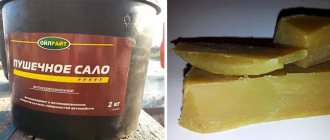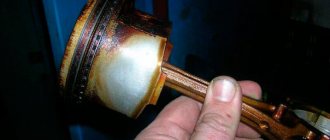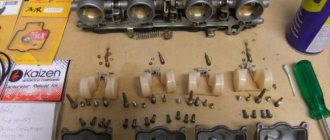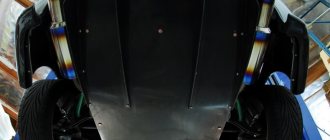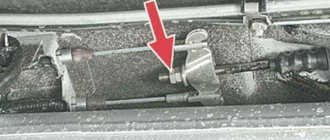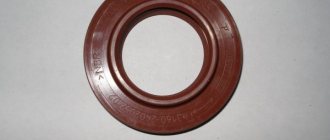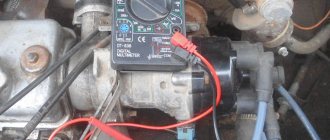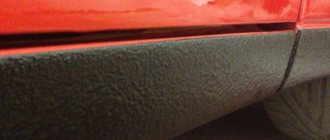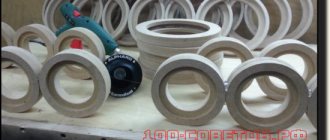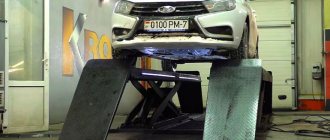What are the benefits of treating a car with cannon fat?
Reviews from car owners who have tried this product on their car will help us study this issue in more detail. Well, we’ll start, as always, with the basics. We all know that cars come off the assembly line with a sparkling paint coating, which, unfortunately, will deteriorate over time. Dusty roads, sand, small pebbles, driving a car in winter - without a doubt, will do their dirty work. Thus, the attractive shine adored by many will begin to fade over time and it will not be difficult to see microcracks in it.
What to do in this case? Yes, use special means to protect paintwork, the list of which includes the cannon lard discussed in our topic.
What is a pushsalo?
Gun lard is a plastic conservation lubricant intended for anti-corrosion treatment of metal surfaces during storage in warehouse conditions.
The lubricant originally developed for these purposes was named UNZ. It was created to protect artillery pieces.
In consistency and color, this lubricant actually resembled lard. This is where the popular name came from - cannon fat.
Then PVK lubricant entered mass production. Its composition was somewhat different from UNZ, but the basic properties and appearance were preserved.
The new lubricant was given the official name “Gun Lubricant” (GOST 19537-83 Gun Lubricant. Technical Conditions). People still call it “Cannon fat” or simply “pushsalo”.
What is the use of pushsala?
Any car owner of “our” cars knows that they rot. And to stop this process you need to give anti-corrosion treatment to your favorite horse or mare (whatever). I spent a long time reading and collecting information. Just learning how to handle my wife's nine.
I read a lot of recipes and tips and decided to do it as in the USSR. So let's start with the theory: There are 2 main types of anticorrosive - mastic and oil.
Mastic holds well, protects for a long time - for several years, but in order for it to be so, the surface must be well prepared - strip the old coating down to the metal, remove any remaining rust with a converter, dry it from moisture, especially in corners, joints, welds .
- On old cars, where corrosion has penetrated deep under the previous coating, providing all these conditions is very problematic and will require a lot of work. If this is not done, a layer of new mastic will simply cover the areas of corrosion along with moisture on top, and the process will continue, only in a hidden form.
- Oil anticorrosive (it is really oil-based) has a much greater penetrating ability, it sufficiently displaces moisture, contains corrosion inhibitors, and does not require careful surface preparation - just peel off the exfoliated pieces of the old coating.
- But the anti-corrosion layer is not particularly resistant; it is recommended to renew the coating at least once a year. It should be noted that there is a composition for the internal cavities and for the bottom. So, when treating the bottom, it is first recommended to spray it with an internal compound. cavities - it penetrates into the smallest cracks, and only then after a few hours - with a composition for the bottom, which, partially polymerizing, will provide more lasting protection against washing off.
Composition and characteristics
The components used largely determine the appearance and performance of any product. To better understand what pushsalo is, you must first consider its composition.
Mineral oil is used as a base fluid for lubricating PVC, and petrolatum, ceresin (about 5%) and its oxides are used as a thickener. To increase the protective properties, the composition of the cannon lard also includes an anti-corrosion additive.
The resulting grease ranges in color from light beige to brown, depending on the type of petrolatum thickener.
Gun oil works well in the temperature range from -50 to +50 ° C and is characterized by high water resistance.
The consistency varies quite a lot depending on the ambient temperature - from semi-liquid (at high temperatures), to viscous (at temperatures close to room temperature) and thick, almost solid (at temperatures from 10 ° C and below). Under normal conditions at room temperature, the composition looks like a plastic thick lubricant, reminiscent of lard.
At temperatures above +50 °C, the lubricant melts and easily drains from the treated surface. In southern regions, where the surface can become very hot in the sun, there are restrictions on the use of this composition.
Down to -50 °C, the lubricant has high stickiness, excellent adhesion to the surfaces being treated and retains excellent anti-corrosion properties. That is why PVK is widely used in middle and northern latitudes.
The stated shelf life of the conservation lubricant is 5 years, but in fact, when stored in a hermetically sealed container, even 10 years after the release date, cannon lard retains its properties.
The scope of problems that the push salo solves is small - the use of this composition is limited to the preservation of equipment and the protection of metal surfaces from corrosion. However, the inexpensive composition copes with these tasks so effectively that it has earned the recognition of tens of thousands of mechanics and car enthusiasts.
Cannon lard is used in its pure form or diluted with various oils, solvents, and other means.
The composition is especially often used for anti-corrosion treatment of cars - it is applied to the bottom, and hidden cavities are filled with it.
A simple device for processing internal cavities (frames)
#1 MihaZ
I would like to share with you a useful device for processing hidden cavities.
It consists of a discharged fire extinguisher, a hose, a pneumatic connector and a spray gun.
I used it to treat the insides of the frame with M5 oil. It worked at a pressure of 7 atm, but it can be less, depending on the capabilities of your compressor and the desired atomization.
In my case, the jet hit about 5-10 cm, the drops scattered more than 0.5-1 m.
The principle of operation is based on the displacement of the anti-corrosion composition by air pressure created by a compressor.
To activate the fire extinguisher lever, the fire extinguisher lever is unscrewed, anti-corrosive agent (in my case oil) is poured inside, then the lever is installed in place and tightened tightly (by hand). A compressor is connected to the pneumatic connector. The sprayer with the hose is inserted into the hidden cavity until it stops, the fire extinguisher lever is pressed and the hose is gradually pulled out.
Upon completion of work and before filling a new portion, the pneumatic connector must be disconnected. In this case, you should not direct the stream of air coming out of the connector towards yourself, there is a lot of pressure there. However, I did not notice any oil blowing out when the connector was disconnected.
The device is made from a used or expired powder fire extinguisher in a garage environment.
If the fire extinguisher is expired, it must be discharged by pressing the lever. It's better not to shake. Most likely there will be quite a bit of powder anyway.
Then unscrew the fire extinguisher lever and pour out the remaining powder.
Drill a hole with a diameter of 6-10 mm in the upper part of the fire extinguisher and weld a 1/4″ coupling
Screw the pneumatic connector into the thread.
Then you need to lengthen the intake tube, otherwise there will always be an unconsumable residue of anticorrosive inside.
Instead of a fire extinguisher spray, you need to screw in a tree-type fitting with a diameter of 8-10 mm with a thread. The thread diameter depends on the fire extinguisher used. I had an M10.
I used a transparent PVC hose with an internal diameter of 8 mm and a length of 3 m.
In order for the anticorrosive agent to be consumed more slowly, holes must be drilled in the upper part of the intake tube, otherwise the entire contents will blow out in a matter of seconds.
I made 4 holes with a diameter of 1.5 mm. In addition, thanks to them, the anticorrosive foams and water shocks occur in the tube, from which the drops scatter much further. Naturally, anticorrosive agent should be poured below these holes.
The atomizer is made from a piece of copper tube. Hole diameter 1.5 mm. The quantity is selected experimentally. I had 10 active holes (the rest were hidden inside the hose).
Attention: the plastic pipe screwed into the lever coupling is very weak! Be careful with him. It broke off and I had to make a new one from a suitable aluminum tube. The difficulty is that inside this pipe there is a stop for the lever valve spring.
#2 Vereshchagin
Thanks for the great idea! This is exactly what I'm doing.
#3 BorBoss
#4 rfgbnfy
I'll put it in my collection of ideas. Thank you!
#5 BorBoss
#6 Vereshchagin
I see only one drawback here - you can only process the frame inside. Then it will stand idle. For external processing of the frame, you will need to use something else.
#7 AnM
For external processing, you can install another nozzle. so that there is a kind of “torch” only forward. for example 3 holes. With such a tube, you can probably get anywhere and carefully spray something on top of the frame.
But something else confuses me about this device. there is no adjustment of the fluid supply, as there is on anti-corrosion/anti-gravel guns. And sometimes this function is very important. For example, when processing something inside the salon. If the anticorrosive agent splashes a lot, then you can cover the plastic as well. But in general, the device is wonderful. especially if all the components are already in the garage.
py.sy. I still bought a gun)))
#8 Vereshchagin
I also bought a pistol, but I will improve it.
There are some interesting ideas I spotted on YouTube.
As soon as I do, I will immediately open a topic.
#9 AnM
Yes . Interesting . what can be altered in the pistol. It seems that everything is there. Several attachments. air reducer. hoses of different lengths. and there are no more fantasies.
#10 Vereshchagin
Then it will be possible to drive the thicker mixture into the frame and cover the outside.
#11 olekula7
I see only one drawback here - you can only process the frame inside. Then it will stand idle. For external processing of the frame, you will need to use something else.
Why idle? I use a similar unit (I bought it in the USSR and the air is pumped by a car pump) to fill the axles, transfer case, and gearbox with oil when replacing it—a very convenient “weight.”
#12 AnM
Then it will be possible to drive a thicker mixture into the frame
Processing instructions
The process of treating a car with cannon fat is quite simple, but it is important to follow some safety requirements and also acquire a number of tools. To apply the substance to the car body you will need:. Cannon fat
In stores you can most often find this substance in containers from 2 to 5 liters. On average, it takes about 1 liter of substance to treat one car;
Cannon fat. In stores you can most often find this substance in containers from 2 to 5 liters. On average, it takes about 1 liter of substance to treat one car;
- Heat source. A regular electric stove, gas burner or something similar can be used here. A heat source is needed to heat the cannon fat;
- Tara. If you do not plan to use a full container of cannon lard, you will need to get a container in which you can heat the required amount of the substance;
- Degreaser. In this case, you can use regular white spirit;
- Application medium. This could be a brush, a paint gun or something similar;
- Sandpaper. If there are elements of corrosion on the car, you will need sandpaper to clean them off first.
Important: Before starting work, be sure to remove the fire extinguisher from the car and place it in a visible place. Since the work involves the use of heating elements, there is a risk of fire
Having prepared the necessary tools, you can proceed to work:
The first step is to heat the cannon fat to a liquid state. This substance melts at a temperature of about 90 degrees Celsius
It is recommended to use an electric stove to heat the substance, so as not to use an open fire, since the powder ignites easily; Please note: Before heating, it is recommended to add 10-20% of the volume of gasoline to the cannon lard in order to obtain a homogeneous mass during heating. It is also necessary to stir it constantly while heating the substance. You will also need to prepare the car for application of the substance.
To do this, it is recommended to remove all plastic elements that may interfere with the work. It will be necessary to clean the dirt from and dry the body parts to which the spray will be applied. If there are any signs of corrosion, remove them with sandpaper. When the body is prepared, degrease it using white spirit or another similar product;
Next, proceed directly to the process of applying cannon lard. You can use any convenient tools for this, but the easiest way to do the job is with a brush. When using a brush, use broad strokes to distribute the product evenly throughout the body.
You can apply cannon fat into hidden cavities using a syringe; Please note: If you use a sprayer to apply gun lard, you can add used machine oil to it while heating the substance to control the thickness
Once the substance is applied to the car, wait about an hour for it to dry before putting the plastic parts back on.
The main advantage of gun lard over other anti-corrosion mastics is its long service life. After treating the body with pushsal, at least 4 years will pass before you have to apply the substance again, while conventional mastics need to be replaced every 1.5-2 years.
There is also a drawback to cannon lard - its stickiness. Even after hardening, road dirt sticks quite strongly to the substance, but this problem can be solved by washing.
What will you need?
To apply this anti-corrosion protection, you will need to prepare some equipment. This list is small and contains almost all the elements available in the garage of a self-respecting car enthusiast. So, you will need:
- Cannon fat
. It is usually sold in 2 or 5 liter buckets. It usually takes about a liter to treat a passenger car; - Electric stove
, you will need it to heat up the lard. If it is absent, then any other heat source can be used; - Container for heating
. Sometimes they heat it directly in a bucket. It makes sense to do this in case of complete use of the substance; - Degreaser
. White spirit will do; - Brush
, paint gun or old syringe for lubricating parts.
In addition, sandpaper may be required to remove rust. Just in case, place a fire extinguisher in a visible place.
Requirements for anti-corrosion coating
The correct anticorrosive agent must have the following properties:
- Form an elastic film on a metal surface.
- Possess a high degree of adhesion - adhesion of various surfaces in solid or liquid form.
- Impregnate not only smooth surfaces, but also penetrate into cracks and depressions.
- Displace accumulated moisture.
- Wet the surface well.
- Should not dry out.
- Do not form cracks where water can penetrate.
- No special surface preparation is required.
- Be resistant to the mechanical effects of small particles rising from the road surface - gravel, sand, pebbles.
- Be resistant to temperature changes and maintain its characteristics at any time of the year.
The use of cannon tallow satisfies these requirements and creates reliable insulation from the environment. The composition of cannon lard is petroleum oil, which is thickened with petrolatum and ceresin. To ensure performance properties, an anti-corrosion additive is added.
The coating received its name due to the fact that it was first used to preserve artillery weapons, including guns.
Advantages
Main features of the substance:
- high degree of elasticity;
- ability to stay on the surface without rolling off during application and further use;
- lack of interaction with water, which allows it to be successfully used on the bottom of a car;
- temperature range of use – from minus 50° to plus 50°C;
- protection against corrosion when exposed to sea water and salt fog;
- Application area: ferrous and non-ferrous metal surfaces.
Visually it is a homogeneous ointment-like mass with a color ranging from yellow to light brown. Sold in metal cans or buckets of various capacities. Packaging starts from 1 kg.
The price of this type of anti-corrosion coating is very affordable. For comparison, the table shows the cost depending on volume and manufacturer.
Preparation
Before applying the coating, you should prepare everything you need. To carry out anti-corrosion treatment you will need:
- cannon fat in a jar or bucket;
- breeding agent;
- electric stove or hair dryer;
- paint brush;
- syringe.
We should especially talk about the breeding agent. There are several options for diluting cannon fat to a liquid state.
For this the following can be used:
- petrol;
- solvent;
- used oil;
- Movil;
- anti-corrosion agent like RUST STOP.
Each of them has its own disadvantages and advantages. The solvent will cost a little more. The processing properties depend on what kind of oil was originally used.
Anti-corrosion agent RUST STOP is one of the substances that successfully fights metal corrosion. Manufacturer: Canadian.
The advantage of RUST STOP is that it never freezes. Being in a semi-liquid state, this product fills all cracks and scratches on the metal surface without damaging the rubber parts. A layer of corrosion inhibitors reliably protects the surface from rust.
This anti-corrosion agent does not require particularly careful preparation of the surface to be treated - it can be applied over a slight layer of rust. As a result, the anti-corrosion treatment technology is significantly simplified and the time for the entire process is reduced. An additional bonus is that the manufacturer uses various fragrances, for example, cherry or strawberry.
Mode of application
First you need to prepare the car. It is necessary to remove all plastic parts that interfere with operation. Rinse the surfaces that will be protected. Remove traces of corrosion. Degrease the surface by wiping it with white spirit.
Then you should prepare the cannon fat. This work consists of heating it and bringing it to the consistency of thick sour cream. You can heat it on an electric stove, stirring constantly. It is also possible to use a hair dryer.
About two minutes after the end of heating, add a solvent or anti-corrosion agent to the melted lard in a ratio of 4:1. The solution is ready for use.
On large surfaces the solution is applied with a paint brush. Treating the underbody of a car with cannon fat requires that the car must be raised on jacks. It will be even more convenient to work while in the inspection hole.
It is wise to place a container below where the excess will drain or drip. Apply cannon lard to the surface using broad strokes. Each layer should be 0.3-0.4 mm thick. When it comes into contact with a cold car, the lard sets quickly. After hardening, you can apply another one on top.
How to dilute cannon lard
The question deserves special attention: how to dilute pushsalo to a liquid state?
This is one of the stages and there is an important nuance here: before heating begins, the mass is diluted with different means, and this must be done because this is the only way you will get a homogeneous material. For breeding you can use:
- petrol;
- solvent;
- Movil;
- used oil.
We have found out how to dilute cannon fat for processing, now let’s move on to the preparatory stage.
Types of preservative lubricants
To provide high-quality protection to the car body, special preservative lubricants are used. There are several main types of such materials:
- oils;
- film-forming inhibited lubricants;
- mastics;
- plastic lubricating compounds.
It is in the latter category that cannon fat belongs. To protect the body from harmful influences, the material should be applied to metal surfaces in a thin layer. The procedure has its own nuances and subtleties that must be observed. After applying cannon fat on the metal of the car body, a protective barrier is created that is not afraid of moisture, water, salts and various deposits. It is possible to achieve an excellent preservative effect. It's still not entirely clear what it is.
Anti-corrosion lubricants are called gun lard, which are very similar in appearance to ordinary lithol or paraffin. This is a budget material that has decent characteristics. It has the texture of an ointment and a characteristic yellow-brown color. The consistency is thick and very sticky. Because of this, you have to work extremely carefully with anti-corrosion lubricant. The basis for making pushsala is petroleum oil. It is thickened by adding petrolatum and ceresin. Manufacturers use additional additives and additives. With their help, it is possible to increase the efficiency of cannon lard and enhance its protective anti-corrosion properties. The set of additives depends on the specific manufacturer of the lubricant preservative material.
What is better to use - reviews from car owners?
On the Internet, in automobile forums, drivers constantly argue about what is better to use when treating a car, lard or Movil. There is no clear answer given. Optimists agree with the opinion of drivers who strongly support Movil. Domestic Movil has gained fame as a cheap product. Its use can be said to be nationwide, if by this word we mean exclusively motorists.
Millions of drivers annually face the problem of corrosive chemical reactions that occur in the car body. Inexpensive Movil helps solve problems. The anti-corrosion product was developed in laboratories in Vilnius and Moscow.
The molecular structure includes:
- machine oil;
- drying oil;
- corrosion inhibitors.
The quality of the product is comparable to European analogues. For liquefaction, they used to dilute with kerosene or white spirit. Many drivers do this now - it’s easier to apply the product to the metal surfaces of the body. Movil's molecular structure contains inclusions of substances that prevent contact of air and moisture with the metal. It turns out that if a domestic product is applied to the body metal parts, the car can be operated in difficult climatic conditions without fear of corrosion.
Scope of application
Since gun lard has excellent anti-corrosion properties, there are no big questions regarding the scope of application of this lubricant. It is actively used in various household and economic industries, and is also regularly used when processing the body and underbody of vehicles. In general, cannon lard can be applied to various metal surfaces, regardless of shape, size or other parameters. The preservative properties of pushsal allow it to successfully exert its protective effect on the processed non-ferrous and ferrous types of metal. But it is important to consider that, like any other protective lubricant, with regular and direct exposure to sunlight, precipitation and temperature changes, the properties of gun fat will gradually fade away. It is necessary to periodically renew the protective layer to prevent the possible formation and spread of rust on metal surfaces.
Gun lard has decent characteristics, thanks to which it is so often used for working with various types of metals. Depending on operating conditions, the intensity of metal wear and external influences, a protective coating made of pushsala can last 3-10 years without losing its effectiveness. The operating temperature range for this lubricant is from -50 to +50 degrees Celsius. This makes it possible to use cannon fat in almost all regions. Only with incorrect application or with overly aggressive action can cracks appear on the surface treated with lard. It is worth adding that the material is characterized by the property of not dissolving in water. This allows you to wash your car multiple times, even with a powerful jet of water. After removing the contaminants, the gun fat will still remain on the surface of the metal and will not lose its protective properties.
Pussalo. Car processing.
Pushsalo is now more of a general name for a material for processing the internal cavities of a car. They came across slightly different types and different colors. Sometimes in the form of a dark fatty mass similar to solid oil, sometimes in the form of a light frozen mass
Lately, it has increasingly come across the “second type.” Therefore, now I dilute it additionally with a mixture of Movil and oil.
— I only use new oil (working out gives a smell in the cabin, and you only need a minimum of new oil. It’s not a pity to have it in such quantities).
I dilute it based on my experience. The experience is as follows. Once I didn’t dilute the fluff and used it on the floors of my car. In winter, I lifted the “rugs” and looked at the condition of the floors. The frozen pushsalo was easily separated from the cold metal in layers, leaving virtually no greasy marks on the metal. Probably now such a “pushsalo” is being produced.
Instructions for correct application
To properly process a car, you need to prepare cannon lard of the selected brand in a volume of 1-2 liters per car, as well as a set of consumables and tools:
- heat source - gas burner, electric stove, hair dryer, any other for heating lard;
- a container for dispensing lubricant from a large canister, which does not make sense to heat;
- degreaser – white spirit, acetone;
- brush, spray gun for applying lard;
- sandpaper if there are already traces of rust on the surface of the parts (needed to remove them).
Since solvent and spray are flammable, and heating will be generated during the work, it is better to place a fire extinguisher near you to be on the safe side.
Preparatory work
As preparation measures, you need to put in order all the details that will be processed:
- remove plastic elements;
- wash the body, dry it, degrease it;
- remove existing rust.
In order for the lard to acquire the desired consistency, it must be diluted to a liquid state, then heated. Usually the lubricant is diluted with gasoline, which can be poured in an amount of 10-20% of the total mass to form a liquid, homogeneous product. Afterwards, the cannon fat is heated to +90 degrees, when the process of melting begins. The fire must be slow to avoid dangerous consequences. The mass is constantly stirred when heated, otherwise it may separate. If you plan to spray the composition with a spray gun, it is recommended to add a little motor oil to it.
Applying gun lard
A large container is placed on the floor of the inspection pit so that the remaining lard flows into it and not onto the floor. If you use a brush for application, try to make wide strokes, which will help to evenly distribute the fluff over the surface of the part. A layer thickness of 0.3-0.4 mm is sufficient, and if the layer is too thin, go over the base again. The easiest way to pour material into thresholds, door openings, and technological holes is with a syringe. After applying the composition proceed as follows:
- dry the car naturally for 1-2 hours;
- return all removed parts to their place;
- start using the car.
Places for processing
Usually, preservation is carried out in those places where moisture tends to accumulate. These include welds, joints of elements, arches, various cavities and voids. Push salo is not used in the car interior, because it has an unpleasant odor.
How to wash off gun fat
Cannon lard is not washed off with water because it does not dissolve in it. However, there are situations when there is a need to remove it from the metal surface. If the drying time of the composition has not yet ended, you can wipe it off with a rag: this is usually required if the application is careless. After mechanically removing most of the grease, the rest can be washed with laundry soap.
To remove unnecessary smears of dried lard, it is recommended to use acetone or any other solvent. But the latter are capable of dissolving the paintwork itself, so you must act with extreme caution. Another option for cleaning the surface from pushsal is to combine kerosene and gasoline (60% and 40%), lubricate the metal with this product, then wipe off the remaining grease with a rag and soap.
Water heated to +50...+60 degrees will also help remove grease stains. The hot liquid warms up the lard, it melts and rubs off well. In winter, this method will be useless. To enhance the effect, it is recommended to drop ammonia into the water.
Preparation before applying pushsal to the underbody of the car
When starting such important procedures, you need to stock up in advance with the required tools, and the actual material for processing. You can buy pushsalo at any time in any auto store - this mixture is very popular among the people. So, what exactly do we need:
- fluff in a bucket or jar;
- means for diluting the composition;
- electric stove;
- paint brush;
- syringe.
Next, we prepare the car itself.
Here you will need to dismantle all plastic elements that will interfere with the process of applying the protective material. Then we wash the surfaces that will be subsequently treated and remove traces of corrosion formations. The next step is to degrease the surface to be treated using white spirit. Now it is time to start preparing the pushsala. The process involves heating and bringing the material to the state of thick sour cream. For heating, it is best to use an electric stove, and the composition itself must be stirred continuously during heating. Approximately a couple of minutes after completion of the operation, a solvent should be added to the molten mass - 4:1. That's it - the protective consistency is ready for use.
Purchase and storage
The cost of cannon fat is low. Usually a small jar of 4-5 kg costs no more than 500 rubles, although small packages are also available for sale. The price of a 40 kg container will be 2,500 rubles, which is very profitable for professionals. Previously, it was possible to purchase the product in military stores. Now it is sold as freely as Movil, nigrol, solid oil and motor oils. To purchase, you should contact any car store that sells similar products. When choosing, it is better to give preference to brands that produce products in accordance with GOST, rather than in accordance with specifications - such products are of higher quality.
The shelf life of cannon lard is very long. If the jar is tightly sealed, it is 5-10 years depending on the manufacturer's specific instructions. However, expired material should not be thrown away either. If the temperature regime remained more or less stable, the lard did not undergo repeated heating and defrosting, it will last for 20 years without losing its properties.
Is there a “best” Movil, and how can it be diluted?
It is impossible to give a definite answer to this question. Each manufacturer promotes its products to the market and claims that it is revolutionary and super-high-quality. We are skeptical about this, and proceed from the demand and opinion of the end consumer. And he tells us that Movil, which is optimal in quality and price, is produced by the Triton and Oilwright brands, which we supply to Belarus.
If there is a need to dilute the Movil, and shaking and slight heating does not help, then you can try using gasoline, white spirit, or another solvent for dilution. The main thing is not to overdo it, and don’t rush to dilute it.
How to use Movil?
The most common places for using Movil are the underbody and sills. This is done to protect against corrosion. In addition, Movil can be used to preserve car body parts and other metal products.
Let us remind you that this product is not for getting rid of rust, but for protecting against it. Therefore, you should not apply it to rust. You can apply Movil to both internal and external body parts. Movil becomes ready for use at temperatures of +10, +20 degrees Celsius, and is applied to cleaned surfaces for better interaction with metal-containing coatings of any nature.
Make sure that Movil does not come into contact with rubber products. It can be applied either with a brush or with a spray bottle. Take precautions and use protective equipment for your eyes, respiratory tract, and other parts of your body.
Price
On average, the price of PVC lubricant is relatively low. For example, for a 39-kilogram drum of cannon fat you will have to pay about 2.5 thousand rubles. True, this amount of lubricant can be used to treat at least a couple of truck tractors, not to mention passenger cars. There are smaller containers - the cost for them varies from 400 to 1.5 thousand rubles, depending on the manufacturer and the volume of the drum itself.
Recipe for breeding pushsala? + other tips.
If someone thinks, as an a-centre, that you can’t do it yourself, then it’s better not to write, why waste your time.
I have an example for ALL SKEPTICS: my father-in-law’s NIVA, six years old, is covered in dots on the outside (white, and as it turns out, UNPRIMED), and the bottom and sills are in perfect condition, although it’s been driven all year and sits on the street. He made Movil, but Movil has been so crap lately, so I want pushsalom. And he coats the bottom with domestic BICOR (60 rub. 3 liters), but here, I want something better, probably complexes. Alexey Dilute with oil on the same tile, in the same jar. Pour oil into a half-empty jar of heated pushsal and stir.
By the way. My experience. This winter, the hood was completely covered with stones (roads near Moscow), it was impossible to touch up the paint - it was cold, the paint did not adhere. I took and covered the edge of the hood (the design looks like a fly trap) with heated pushsal. In the spring I washed it off - everything was exactly the same as it was. Where there was pure metal, it was preserved.
Source
Feedback on pushsal treatment
The price of cannon fat in the regions of the country ranges from 100...180 rubles. for 1 kg, which predetermines its widespread use. Car owners point out the following advantages of the product:
- High elasticity of the treated surface.
- Resistance to water and aqueous solutions.
- Efficient over a wide temperature range.
Many reviews note that the durability of coatings using gun fat increases significantly if Canadian-made Rust Stop anticorrosive agent is added to the mixture: the antioxidant resistance of parts increases. In order to increase heat resistance at high operating temperatures, some car owners recommend adding 33K-3u conservation lubricant to the pushsal.
Recipe for breeding pushsala? + other tips.
If someone thinks, as an a-centre, that you can’t do it yourself, then it’s better not to write, why waste your time. I have an example for ALL SKEPTICS: my father-in-law’s NIVA, six years old, is covered in dots on the outside (white, and as it turns out, UNPRIMED), and the bottom and sills are in perfect condition, although it’s been driven all year and sits on the street. He made Movil, but Movil has been so crap lately, so I want pushsalom. And he coats the bottom with domestic BICOR (60 rub. 3 liters), but here, I want something better, probably complexes. Alexei
Dilute with oil on the same tile, in the same jar. Pour oil into a half-empty jar of heated pushsal and stir.
By the way. My experience. This winter, the hood was completely covered with stones (roads near Moscow), it was impossible to touch up the paint - it was cold, the paint did not adhere. I took and covered the edge of the hood (the design looks like a fly trap) with heated pushsal. In the spring I washed it off - everything was exactly the same as it was. Where there was pure metal, it was preserved.
Source
Useful tips
It is recommended to apply the composition not only to the arches, but also to the seams after welding. This way we preserve the places most susceptible to moisture accumulation. There are some more tips:
- If you use gasoline or other odorous compounds, you should not treat surfaces inside the car with gun fat. Otherwise, you will have to suffer for a long time from the unpleasant odor that will be absorbed into the upholstery.
- Although cannon fat can withstand +50 degrees, often already at +40 the mass begins to “slip”. Therefore, if you live in a region with a hot climate, it is recommended to add ceresin 67 or 80 (up to 5%) or a little ceresin oxide. This will prevent the composition from rolling off, and it will remain stable even at +50 degrees.
- If you plan to apply gun oil at an ambient temperature of +10 or below, then you need to be prepared for the composition to thicken too quickly. Therefore, it is very difficult to apply it with a brush.
- Wear protective gloves while working and do not allow gun grease to come into contact with your eyes or skin. It is recommended to carry out processing in a warm and well-ventilated area (especially if you are using gasoline).
Advantages and disadvantages
When used correctly, the product will bring a lot of positive effects and help reliably protect your car from corrosion. Here are its advantages:
- excellent degree of adhesion, long-term retention on surfaces;
- sufficient elasticity;
- the ability to withstand the action of fresh and salt water, salt fog, displacement of moisture already present on the surface;
- filling cracks, holes, hidden cavities;
- wide operating temperature range;
- no need for complex preparation (paint removal, priming, etc.);
- long-term action in any operating conditions;
- simple work even for a beginner;
- low price.
The downside is that the product is quite thick and sticky. Even after drying, it sticks to the hand; moreover, dust and other contaminants actively remain on the lubricant layer. It must be said that washing off the dirt will not be difficult: it is easily separated after water gets in, while the lard itself remains in the same place.
Comparison with other types of funds
Now there are many other products on sale designed for anti-corrosion protection of metal. These are various lubricants, corrosion inhibitors, protective films, car preservatives, anti-corrosive push, oils with additives. Many have slightly improved technical characteristics, but their price is much higher. Therefore, cannon lard is considered among motorists to be the most reliable, high-quality and proven product, which many regularly prefer.
Choosing a product for treating car thresholds with your own hands
Despite the abundance of various means of protecting thresholds from corrosion, many car enthusiasts are wondering: how to treat thresholds? We will give a complete and comprehensive answer to this question. It will help the car enthusiast make the right choice.
1. Anti-corrosion spray BODY-950, capacity 400 ml
Anti-gravel, created on the basis of special resins. Has high adhesion and is resistant to damage. Application requires the use of a special gun. Dries quickly. Cost 4-6$.
Anti-gravel aerosol ELTRANS, capacity from 400 to 1000 ml.
Inexpensive but effective remedy. Does not require the use of a special gun. Consumption of one layer is 400 grams per 1 m². It is recommended to apply in 2-3 layers. Cost for 400 ml. 2-3$.
Anti-gravel KERRY, capacity 650ml.
High-quality anti-gravel that provides effective protection of thresholds. Has a high degree of adhesion. Does not require special skills to use. Cost 3-4$.
voice
Article rating
Types of funds
The set makes up an impressive list, but we will limit ourselves to the names of liquid funds. The list is:
- practice-tested mastics;
- inhibited compositions containing molecular inclusions of petroleum products that form protective films;
- oils that prevent oxygen from penetrating metal components and parts;
- lubricants with universal plastic properties.
The last resort is pushsalo. Practice has proven that pushsalo will be an effective talisman for body metal against rust. It is enough to apply a thin layer of a protective product on metal surfaces so that the feeling of fear for your car will forever disappear from the driver’s soul.
For example, the bottom of the car will become inert to the effects of rain, melt water, dust, impacts of small pebbles, and road salt from ice. That is, treatment with cannon fat will become a panacea for all negative road misfortunes.
We apply pushsalo ourselves
The work is not difficult, but it is performed in several stages. There is no need to rush, it is better to properly process the body once and forget about the problem for a long time. First you need to prepare everything you need.
Preparatory work
The first step is to prepare the surfaces for processing. To do this you need:
- Remove all plastic elements that could accidentally get grease on them.
- If corrosion has already begun to form on the bottom or other parts of the car, then it is worth cleaning it thoroughly with regular sandpaper.
- Degrease surfaces (usually use White Spirit). Gun lard adheres well to any metal, but degreasing will extend the service life of the protective film.
After this, we prepare everything necessary for work:
- Cannon fat.
- Device for heating the composition. Some use gas torches or hair dryers. But in this case there is a risk of ignition of the liquid. Therefore, it is safest to use an electric stove.
- Containers. One container must be suitable for heating. A second container will be needed to allow excess lard to drain into it during work.
- Brushes, a paint gun, a syringe and other products that will allow you to apply the composition to the right places.
In order to heat the cannon oil and obtain a creamy, homogeneous mass, you will need diluting agents. Some car owners use gasoline or solvent, others prefer used oil, Movil or RUST STOP anti-corrosion compounds (or other anti-corrosion agents). The last option is the best. In this case, you will receive a uniform composition, and the final coating will be more resistant to rust. Another advantage of anticorrosive is that it does not have such a pungent odor as gasoline or other compounds.
When everything is ready, you can proceed to processing.
Applying cannon fat
First you need to melt the cannon fat. It begins to become quite liquid at a temperature of 90 degrees. Therefore, we add a little (about 10% of the total mass) gasoline, solvent or anticorrosive to it and put the mixture on the tile. During the heating process, you need to continuously stir the mass. As a rule, the composition acquires the desired consistency after a few minutes.
Some people first pour in a little gasoline, and then add anticorrosive agent to the heated mixture in a ratio of 4:1. After this, we immediately begin processing.
Healthy! The solution cools quite quickly and hardens again.
- We place a container on the floor of the inspection pit into which drops of lard will flow.
- Take a large brush and apply the composition in large strokes to the largest parts of the surface. The layer thickness should be about 0.3-0.4 mm. Please note that the surface of the car is cold, so the composition will set quickly.
- If the layer is too thin, apply the brush again.
- We pour liquid lard into the technological holes, treat the thresholds and doorways. In order to pour the composition into hard-to-reach places, it is recommended to use a syringe.
After this, it is enough to dry the car for 1-2 hours. Ready! Now you can use the car as usual, regardless of whether it’s summer or winter.
Cannon lard is used for anti-corrosion treatment of car bodies. Its advantage is the ability to stay on any surface.
Gun lard is impervious to water, so it can be used, among other things, to protect the underbody of a car and sills from corrosion. The substance is suitable for both ferrous and non-ferrous metals. It is worth noting that cannon lard retains its properties at temperatures from -50 to +50 degrees Celsius.
Interesting fact: Initially, cannon lard was used to preserve small arms and artillery weapons.
The shelf life of cannon lard is unlimited.
